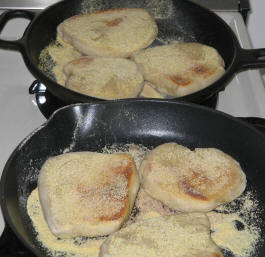Mattone in action
The most delicious chicken dish in the universe is chicken al mattone, or chicken under a brick. If you cook lots of chicken then I would purchase a mattone, which is a two-piece affair: a shallow terracotta dish – kind of like a cazuela, but with shorter, straight sides and glaze on the inside only. Piece #2 is a teardrop-shaped terracotta weight. You use this contraption on the stovetop to cook a butterflied, oiled and seasoned bird by pressing it into the shallow pan with the heated weight. You will wind up with highly flavored meat and crispy skin. Honestly, you won’t believe how good this chicken turns out. Clearly there is something to cooking in clay that is more than the sum of its parts.
I honed a recipe that works with pieces and uses only a few ingredients. Here’s what you do: Wash and dry a whole butterflied chicken or pieces and set aside. Put the mattone press (the top part) into a cold oven and set the heat to 375 F. Wait about 10 minutes. Place the mattone base on your burner with medium heat. No need to use a flame tamer, but I guess you can if you want to. Immediately pour in about 1/3 cup of good olive oil and sprinkle in a handful of dried oregano, some ground black pepper and kosher salt. No need to use fresh oregano because the cooking method opens up the dried version fine. When the oil is hot, put in the chicken – skin side down. If you have a whole chicken you’ll crowd the pan, which is fine. Strew some oregano and S & P on top of the chicken and drizzle on a bit of olive oil. Remove the press from the oven with a good mitt and place directly on top of chicken, pressing down firmly but not with enough force to knock your range over. You get the idea. Turn down the flame so you maintain a little sizzle but not too much; a smidgen over low should work. When it comes time to take the chicken out of the pan, first remove the press and set it on a wooden board or some other surface that is not cold. Remember, a rapid temperature change will cause clay cookware to crack! Test the temperature of each chicken piece with an instant-read thermometer to make sure it is done. As of this entry you want 165 F., but be sure to check current requirements with the USDA often, since they change. The chicken will stick to the bottom of the pan, so use a straight-sided spatula of some ilk to loosen it before you scoop it out. This process can be fairly intense but if you are patient and work under the skin with some oomph and a slight back-and-forth motion, you’ll get it out intact. I place the pieces on a huge platter of spring mix and then spoon the drippings, which are so good this dish should be illegal, over the top. The warm “dressing” is all that is needed on the salad. I serve this with some rice and roasted peppers, which I’ll give you the recipe for tomorrow, I promise. Notes: If you want to butterfly a chicken, take a good set of kitchen shears and make one continuous cut along each side of the backbone starting at the pope’s nose and ending at the top. Then open the chicken up and press it down (with the skin side facing up). Plunk that long backbone in the freezer for congee or stock. If you don’t want to get a mattone, use any clay dish (glazed on the inside) with sides that may be used on the stovetop as the base, and a few clean bricks for the press. Some people wrap the bricks in foil, but I do not. When I first buy the bricks I wash them well and then bake for quite some time to clean and sterilize, and then wash them thoroughly after each use. You won’t get the same results but the dish will still be tasty. If I don’t want a mess, I crimp foil under the base of the mattone all the way around as I place it on the stovetop so I have a “wall of foil” around the whole setup. When I have the press on, I then tent the affair by placing a sheet of foil on top. The cooking chicken can still breathe (you don’t want it airtight) but it provides a little more heat for the chicken to cook through while keeping all the spritzing oil at bay.

